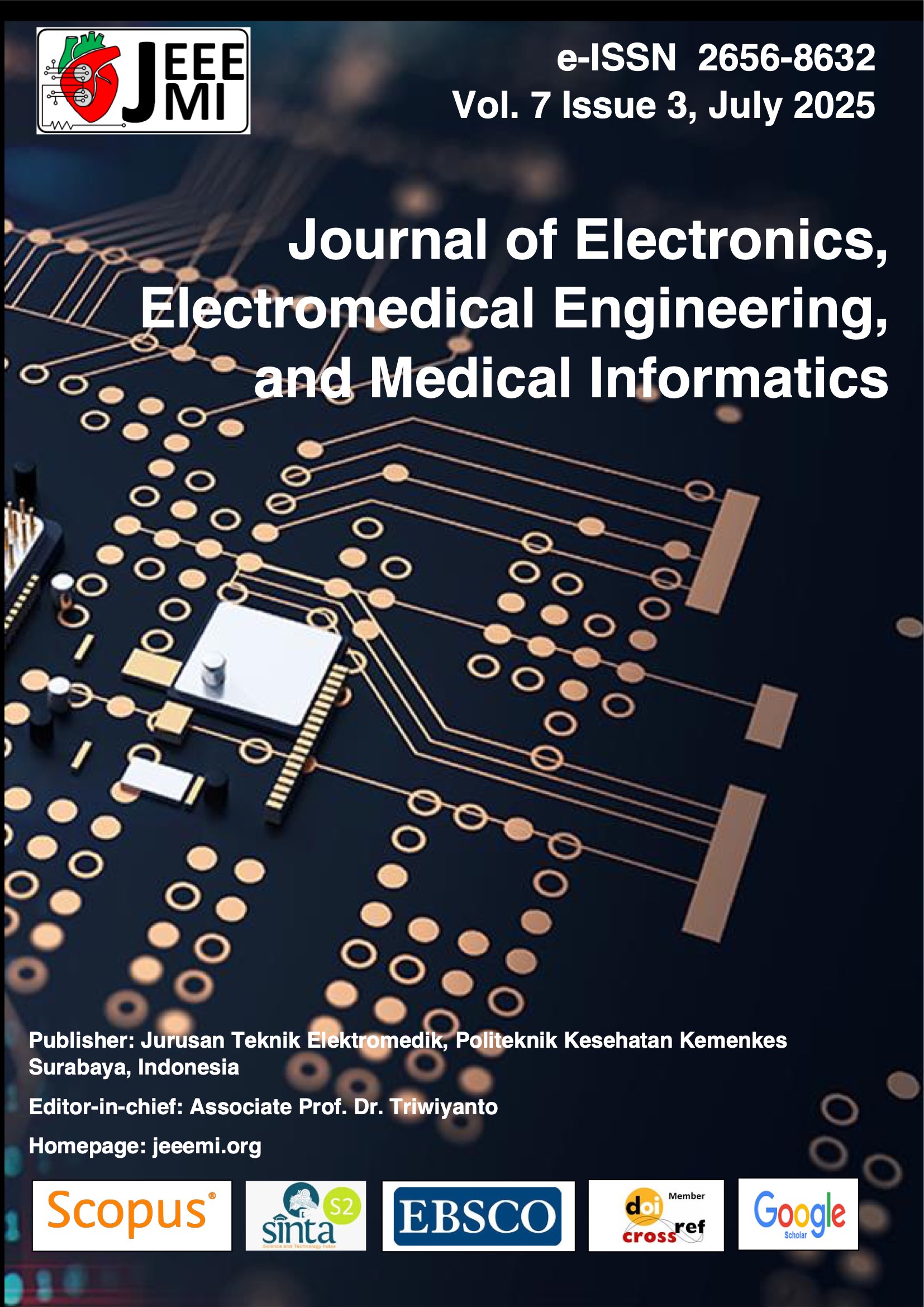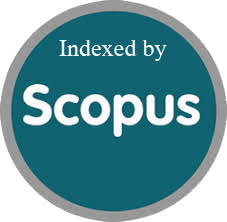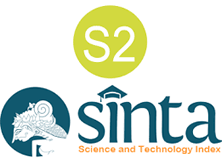Machine Learning-Based Approach for Uterine Cancer Detection and Classifier Evaluation
Abstract
The necessity of early diagnosis of abnormal cell growth is critical to support patient monitoring and earlier clinical analysis. Uterine cancer is the most common gynecological malignancy among women, with endometrial cancer being the predominant type occurring in the endometrial layer. Endometrial cancer is a commonly identified type of uterine cancer that majorly occurs in the endometrial layer. This research applies machine learning (ML) algorithms to detect uterine cancer using texture-based features extracted from medical images. Specifically, a hybrid combination of Grey Level Co-occurrence Matrix (GLCM) and Grey Level Run Length Matrix (GLRLM) properties is proposed to derive 34 features, including entropy, long-run emphasis, short-run low grey level emphasis, and high grey level run emphasis. To ensure data quality, a comprehensive dataset was collected and preprocessed, followed by the implementation of an improved approach for feature normalization and ranking. The top-ranked features were then used to train and validate multiple ML algorithms, including Adaptive Neuro-Fuzzy Inference System (ANFIS), K-Nearest Neighbor (K-NN), Linear Discriminant Analysis (LDA), Radial Basis Function (RBF), Support Vector Machine (SVM), Naïve Bayes (NB), and Artificial Neural Network (ANN). Results show that the best-performing algorithm achieves an accuracy of 97.3%, sensitivity of 96.3%, and specificity of 99.2%. The algorithm's performance was further validated using Receiver Operating Characteristics (ROC) analysis and F1 scores, both of which demonstrated superior predictive capability. Additionally, Explainable AI (XAI) techniques were integrated to elucidate the features and patterns recognized by the algorithm as indicative of endometrial carcinoma. Layer-wise relevance propagation (LRP) was employed to backtrack the neural network’s output decisions to the input features, highlighting the most influential factors in the algorithm's predictions. This research demonstrates the potential of applying ML algorithms to improve early detection of uterine cancer, offering a non-invasive, accurate, and cost-effective alternative to traditional imaging methods.
Downloads
References
N. Sriraam and L. Vinodashri, “A Computer Aided Diagnostic Tool for the Detection of Uterine Fibroids,” Int. J. Biomed. Clin. Eng., vol. 2, no. 1, pp. 26–38, Jan. 2013, doi: 10.4018/ijbce.2013010103.
Z. A. Al-Saffar and T. Yildirim, “A Novel Approach to Improving Brain Image Classification Using Mutual Information-Accelerated Singular Value Decomposition,” IEEE Access, vol. 8, pp. 52575–52587, 2020, doi: 10.1109/ACCESS.2020.2980728.
Z.-Y. Wei, Z. Zhang, D.-L. Zhao, W.-M. Zhao, and Y.-G. Meng, “Magnetic resonance imaging-based radiomics model for preoperative assessment of risk stratification in endometrial cancer,” World J. Clin. Cases, vol. 12, no. 26, pp. 5908–5921, 2024, doi: 10.12998/wjcc.v12.i26.5908.
J. N. B.-G. B. Long, M. A. Clarke, A. D. M. Morillo, N. Wentzensen, Ultrasound detection of endometrial cancer in women with postmenopausal bleeding: Systematic review and meta-analysis, vol. 157, no. 3. 2020. doi: https://doi.org/10.1016/j.ygyno.2020.01.032.
V. Chiappa et al., “Using Radiomics and Machine Learning Applied to MRI to Predict Response to Neoadjuvant Chemotherapy in Locally Advanced Cervical Cancer,” Diagnostics, vol. 13, no. 19, pp. 0–11, 2023, doi: 10.3390/diagnostics13193139.
Yanyan Yua ∙ Xingqing Qina ∙ Yongmei Huanga ∙ Jinyuan Liao Yuanfang Taoa,1 ∙ Yuchen Weia, “Development and Validation of a Nomogram Based on Multiparametric MRI for Predicting Lymph Node Metastasis in Endometrial Cancer: A Retrospective Cohort Study,” Acad. Radiol., vol. Volume 32, no. 5, pp. 2751–2762, 2024, doi: 10.1016/j.acra.2024.12.008.
G. Nallasivan, M. Vargheese, J. Banukumar, and A. Ahila, “An Automated and Improved Brain Tumor Detection in Magnetic Resonance Images,” vol. 12, no. 11, pp. 3370–3378, 2021.
J. Liu and Z. Wang, “Advances in the Preoperative Identification of Uterine Sarcoma,” Cancers (Basel)., vol. 14, no. 14, pp. 1–15, 2022, doi: 10.3390/cancers14143517.
B. J. 1 Xueliang Zhu 1, Jie Ying 2, Haima Yang 1, Le Fu 3, Boyang Li 1, “Detection of deep myometrial invasion in endometrial cancer MR imaging based on multi-feature fusion and probabilistic support vector machine ensemble,” Comput. Biol. Med., vol. Jul;134:10, no. May 11, 2021, doi: 10.1016/j.compbiomed.2021.104487.
G. L. A et al., “Machine learning for prediction of concurrent endometrial carcinoma in patients diagnosed with endometrial intraepithelial neoplasia,” Eur. J. Surg. Oncol., vol. Volume 50, no. Issue 3, p. 108006, 2024, doi: https://doi.org/10.1016/j.ejso.2024.108006.
Y. Zhang, C. Gong, L. Zheng, X. Li, and X. Yang, “Deep Learning for Intelligent Recognition and Prediction of Endometrial Cancer,” J. Healthc. Eng., vol. 2021, 2021, doi: 10.1155/2021/1148309.
T. Y. 2 Masatoyo Nakajo 1, Megumi Jinguji 2, Atsushi Tani 2, Erina Yano 2, Chin Khang Hoo 2, Daisuke Hirahara 3, Shinichi Togami 4, Hiroaki Kobayashi 4, “Machine learning based evaluation of clinical and pretreatment 18F-FDG-PET/CT radiomic features to predict prognosis of cervical cancer patients,” Abdom. Radiol., vol. 47, no. Nov., pp. 838–847, 2021, doi: 10.1007/s00261-021-03350-y.
S. O. A et al., “Radiomic machine learning for pretreatment assessment of prognostic risk factors for endometrial cancer and its effects on radiologists’ decisions of deep myometrial invasion,” Magn. Reson. Imaging, vol. 85, pp. 161–167, 2022, doi: https://doi.org/10.1016/j.mri.2021.10.024.
P. P. Mainenti et al., “MRI radiomics: A machine learning approach for the risk stratification of endometrial cancer patients,” Eur. J. Radiol., vol. 149, no. September 2021, p. 110226, 2022, doi: 10.1016/j.ejrad.2022.110226.
Z. et al. Huang, ML., Ren, J., Jin, “Application of magnetic resonance imaging radiomics in endometrial cancer: a systematic review and meta-analysis.,” Radiol med, vol. 129, pp. 439–456, doi: https://doi.org/10.1007/s11547-024-01765-3.
J. S. A et al., “Gynecological cancer prognosis using machine learning techniques: A systematic review of the last three decades,” Artif. Intell. Med., vol. Volume 139, no. May, p. 102536, 2023, doi: https://doi.org/10.1016/j.artmed.2023.102536.
S. Shanmugam and S. Dharmar, “Very large scale integration implementation of seizure detection system with on-chip support vector machine classifier,” IET Circuits, Devices Syst., vol. 16, no. 1, pp. 1–12, 2022, doi: 10.1049/cds2.12077.
S. Brindha and J. Justin, “Comparative Analysis on De-Noising of MRI Uterus Image for Identification of Endometrial Carcinoma,” Front. Biomed. Technol., vol. 10, no. 3, pp. 299–307, 2023, doi: 10.18502/fbt.v10i3.13159.
D. C. Rini Novitasari, A. Lubab, A. Sawiji, and A. H. Asyhar, “Application of feature extraction for breast cancer using one order statistic, glcm, glrlm, and gldm,” Adv. Sci. Technol. Eng. Syst., vol. 4, no. 4, pp. 115–120, 2019, doi: 10.25046/aj040413.
M. P. 1 Carolina Bezzi 1 2, Alice Bergamini 1 3, Gregory Mathoux 4, Samuele Ghezzo 1 2, Lavinia Monaco 4, Giorgio Candotti 3, Federico Fallanca 2, Ana Maria Samanes Gajate 2, Emanuela Rabaiotti 3, Raffaella Cioffi 3, Luca Bocciolone 3, Luigi Gianolli 2, GianLuca, “Role of Machine Learning (ML)-Based Classification Using Conventional 18F-FDG PET Parameters in Predicting Postsurgical Features of Endometrial Cancer Aggressiveness,” Cancers (Basel)., vol. 15, no. 1, p. 325, 2023, doi: doi: 10.3390/cancers15010325.
H. Ganesan, Karthick & Rajaguru, “Performance analysis of KNN classifier with various distance metrics method for MRI images,” Soft Comput. Signal Process., p. pp 673–682, doi: DOI:10.1007/978-981-13-3600-3_64.
W. L. a B, Q. G. c D, M. D. c E, W. C. F, and T. T. c G, “Multiclass diagnosis of stages of Alzheimer’s disease using linear discriminant analysis scoring for multimodal data,” Comput. Biol. Med., vol. Volume 134, p. 104478, 2021, doi: https://doi.org/10.1016/j.compbiomed.2021.104478.
C. M. A. K. Z. Basha, T. S. Teja, T. R. Teja, C. Harshita, and M. R. S. Sai, “Advancement in Classification of X-Ray Images Using Radial Basis Function with Support of Canny Edge Detection Model,” Comput. Vis. Bio-Inspired Comput., pp. 29–40., 2021, doi: DOI:10.1007/978-981-33-6862-0_3.
S. Jayachitra and A. Prasanth, “Multi-Feature Analysis for Automated Brain Stroke Classification Using Weighted Gaussian Naïve Bayes Classifier,” J. Circuits, Syst. Comput., vol. 30, no. 10, 2021, doi: 10.1142/S0218126621501784.
Virupakshappa and B. Amarapur, “Computer-aided diagnosis applied to MRI images of brain tumor using cognition based modified level set and optimized ANN classifier,” Multimed. Tools Appl., vol. 79, no. 5–6, pp. 3571–3599, 2020, doi: 10.1007/s11042-018-6176-1.
R. Trevethan, “Sensitivity, Specificity, and Predictive Values: Foundations, Pliabilities, and Pitfalls in Research and Practice,” Front. Public Heal., vol. 5, no. November, pp. 1–7, 2017, doi: 10.3389/fpubh.2017.00307.
B. Samarasam and J. Justin, “Enhanced Classification of Endometrial Carcinoma Using Machine Learning Powered by Explainable AI,” African J. Biomed. Res., vol. 28, no. 1, pp. 158–165, Jan. 2025.
A. S. A and K. Manivannan, “Fusion based Glioma brain tumor detection and segmentation using ANFIS classification,” Comput. Methods Programs Biomed., vol. Volume 166, no. November, p. Pages 33-38, 2018, doi: https://doi.org/10.1016/j.cmpb.2018.09.006.
I. Bajla and M. Teplan, “Yeast cell detection in color microscopic images using ROC-optimized decoloring and segmentation,” IET Image Process., vol. 16, no. 2, pp. 606–621, 2022, doi: 10.1049/ipr2.12376.
Database: https://www.cancerimagingarchive.net/
collections/captac-ucec/
Copyright (c) 2025 Brindha Samarasam, Judith Justin

This work is licensed under a Creative Commons Attribution-ShareAlike 4.0 International License.
Authors who publish with this journal agree to the following terms:
- Authors retain copyright and grant the journal right of first publication with the work simultaneously licensed under a Creative Commons Attribution-ShareAlikel 4.0 International (CC BY-SA 4.0) that allows others to share the work with an acknowledgement of the work's authorship and initial publication in this journal.
- Authors are able to enter into separate, additional contractual arrangements for the non-exclusive distribution of the journal's published version of the work (e.g., post it to an institutional repository or publish it in a book), with an acknowledgement of its initial publication in this journal.
- Authors are permitted and encouraged to post their work online (e.g., in institutional repositories or on their website) prior to and during the submission process, as it can lead to productive exchanges, as well as earlier and greater citation of published work (See The Effect of Open Access).





.png)
.png)
.png)
.png)
.png)
